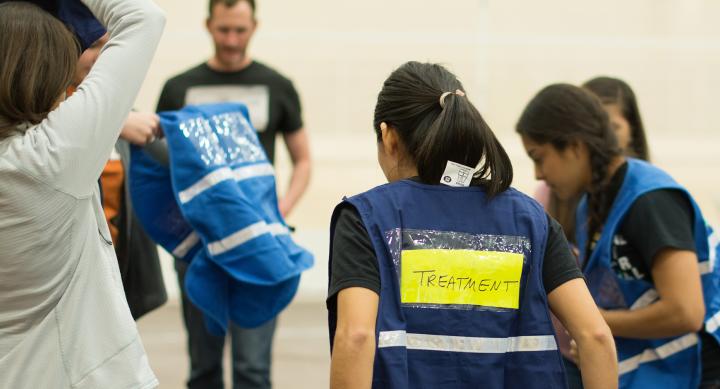
After 9/11 and Hurricane Katrina, collaborative planning and leadership between The University of Texas and the City of Austin resulted in a memorandum of cooperation to coordinate preparedness and response activities. Students, faculty and staff at The University of Texas can augment City of Austin resources and assist in staffing mass shelters or mass immunization clinics.
The University of Texas at Austin School of Nursing is committed to its role in preparing future nurses with foundation knowledge and simulation experiencein disaster preparedness, response and recovery. This preparation aids both our internal university system as well as the larger Austin community, in a variety of ways.
- Fostering the availability of trained and vetted nursing volunteers: faculty, staff and students.
- Templates and guidance developed at the School of Nursing may be helpful to other health professions schools.
- Trained nurses save lives.
Contact Information
Disaster Preparedness Committee Chair
Li-Chen Lin, PhD, RN
Email: llin@mail.nur.utexas.edu
Phone: 512-471-5069
UTMRC Director
Shalonda Horton, PhD, RN
Email: shorton@mail.nur.utexas.edu
Phone: 512-475-8694
Partnerships
Memorandum of Understanding between City of Austin & the University of Texas
Following Hurricane Katrina, the City of Austin approached the School of Nursing with a request to formalize our relationship in the event of future disasters. The intent was to streamline and strengthen the process to call-up volunteers. The purpose of the memorandum is to delineate the “cooperative efforts to be undertaken by City of Austin and the School of Nursing, the College of Pharmacy, and the Steve Hicks Social Work, in relation to preparedness for large scale medical shelters and vaccination or prophylactic medication clinics in the event of a disaster, terrorist event, or in the event clinics are otherwise required due to a public health emergency.”
UT Austin: Nursing - Social Work - Pharmacy
The School of Nursing is providing a template for action and organization to the College of Pharmacy and the Steve Hicks Social Work. The Disaster Mobilization Plan and the committee structure for the School of Nursing was shared with the College of Pharmacy, and the Steve Hicks Social Work. Each school and professional discipline can bring strengths, skills, and talent to a disaster response event. Pharmacy students and faculty can perform intake and patient assessments, administer vaccinations, assess medication needs and perform pharmaceutical dispensing functions. Social Work students and faculty can perform intake and patient assessments, triage evacuees or patients, initiate on-site case management, and provide crisis counseling.
University Health Services (UHS)
As a follow-up to a University-wide table top exercise on pandemic influenza in December 2006, University Health Services (UHS) initiated extensive planning for handling a pandemic influenza outbreak. UHS has developed an detailed plan for reconfiguring the Health Center, modifying patient flow and intake, and setting up a 24 hour hotline to provide health and treatment information for callers (in anticipation of an emphasis on in-home care for sick students). The School of Nursing may provide assistance with the telephone hotline and triage activities.
The University of Texas Medical Reserve Corps (UTMRC)
The idea to create a University of Texas at Austin Medical Reserve Corps (UTMRC) was generated by the University of Texas at Austin School of Nursing Disaster Committee. This is in response to the university’s need to organize and maintain a group of volunteers (comprising of faculty, staff, and students) willing and prepared to assist in public health issues and emergencies on campus. The function of the unit is to bolster the existing emergency response teams and public health advocates on campus. Though the UTMRC is created in the School of Nursing, volunteers from all departments campus-wide are encouraged to participate.

